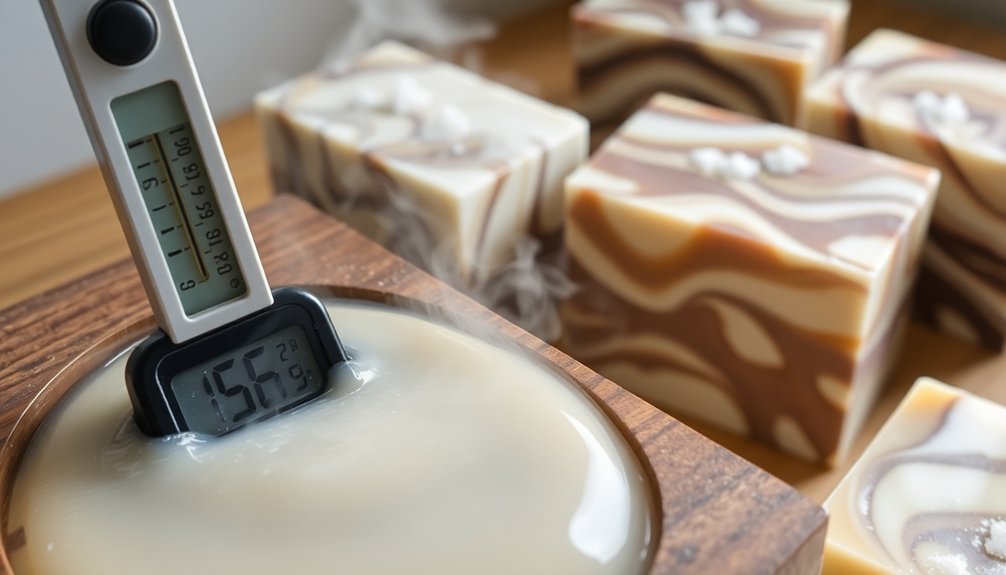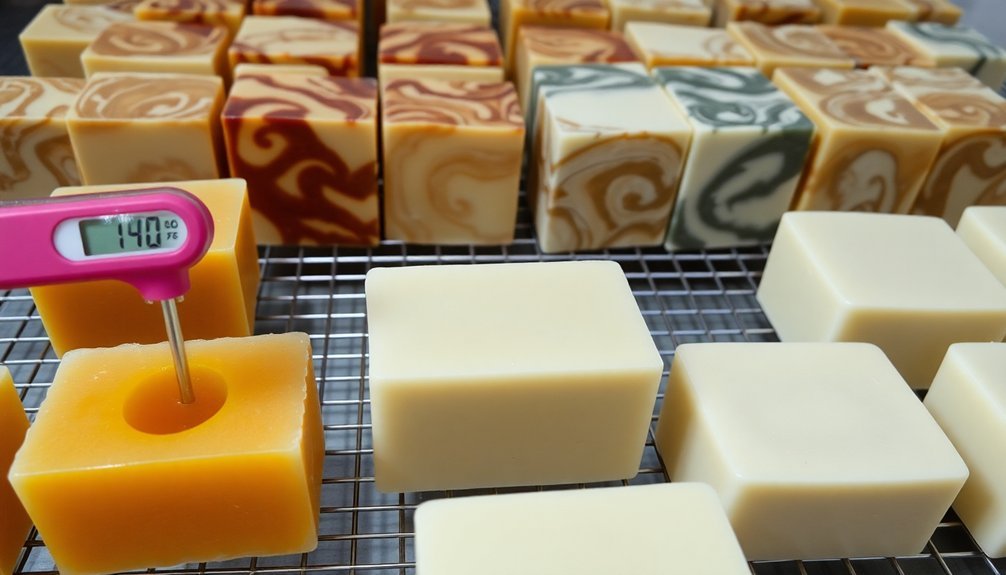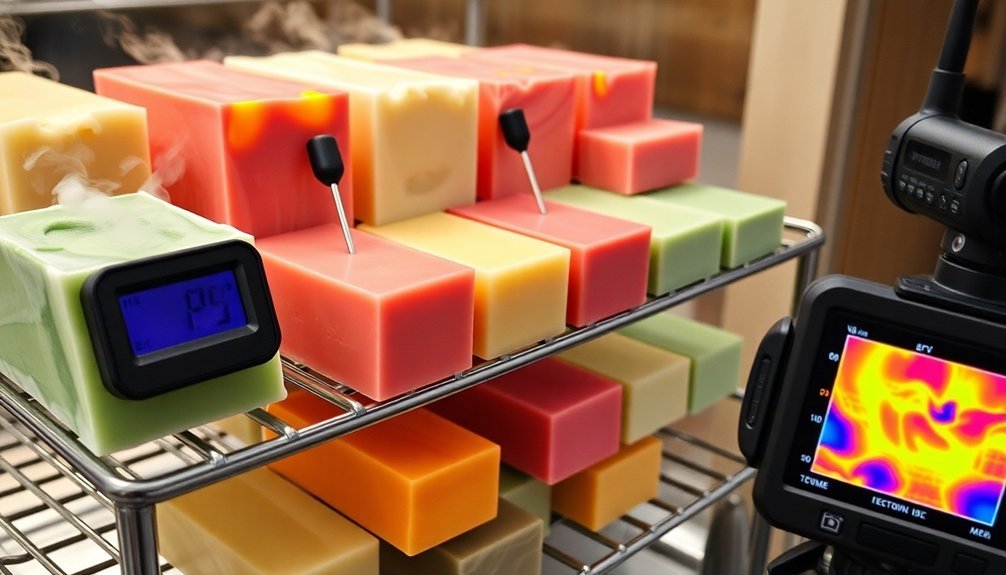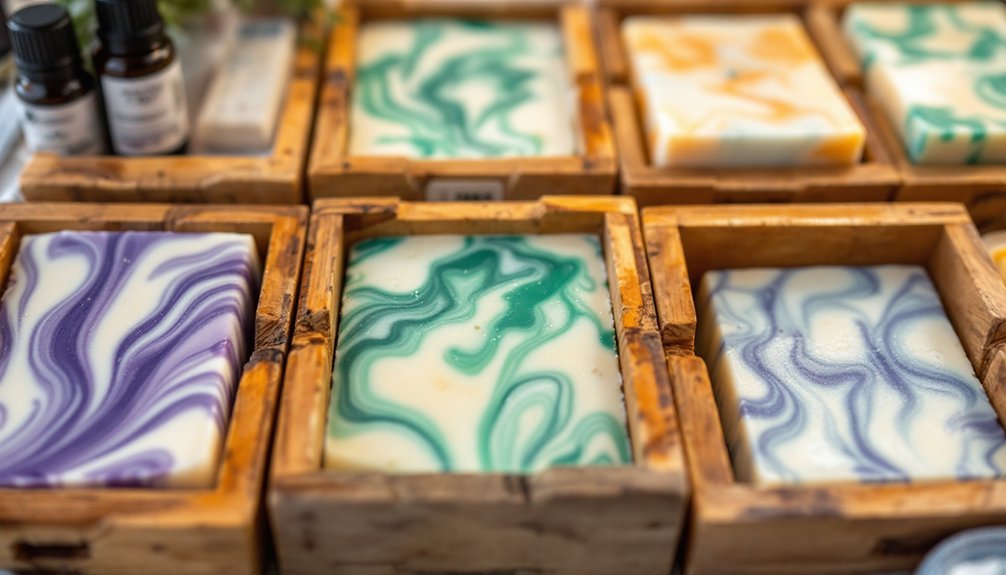Soaps must cool at specific temperatures (90°F-110°F) to guarantee proper saponification and prevent defects. When you maintain this ideal range, you'll avoid false trace, glycerin rivers, and soda ash while promoting even crystallization. Proper cooling enhances color vibrancy, maintains shape, and creates a smooth texture in your final product. Temperature control also affects how your soap gels, ultimately determining whether you'll achieve a glossy finish or pastel appearance. The perfect temperature makes all the difference.
The Science Behind Optimal Cooling Temperatures in Saponification

While many soapmakers develop an intuitive feel for temperatures over time, understanding the science behind ideal cooling temperatures reveals why precision matters so much in saponification.
Optimal cooling temperatures (90°F-110°F) create the perfect environment for soap making oils and lye solution to combine effectively. When you maintain these components within 10 degrees of each other, you prevent false trace and guarantee proper emulsification.
Cooling your lye solution to 120-130°F before mixing safeguards against overheating issues like volcanoes or glycerin rivers.
Temperature control also influences the gel phase, enhancing color vibrancy and minimizing soda ash formation on your soap's surface. Using a digital thermometer helps you track temperature fluctuations with accuracy, leading to consistent results.
The saponification process requires this precision—it's chemistry, not just crafting.
How Temperature Ranges Affect Soap Texture and Appearance
Temperature control during soap cooling directly influences crystallization patterns, with the ideal 90-110°F range preventing structural warping that can ruin your batch.
You'll notice that proper cooling temperatures maintain the integrity of your soap's shape while preventing common defects like alien brain formations or soda ash development.
The heat level you choose will also greatly impact your soap's color development, as higher temperatures enhance vibrancy through a complete gel phase while cooler settings produce more muted, opaque finishes.
Cold Process Affects Crystallization
When crafting cold process soaps, the temperature range you maintain directly influences how fats crystallize during saponification. Keeping your mixture between 90°F-110°F guarantees proper crystallization while preventing false trace—that frustrating premature thickening that creates grainy textures.
| Temperature Effect | Crystallization Impact | Visual Result |
|---|---|---|
| Too Cool (<90°F) | Irregular crystallization | Grainy texture |
| Ideal (90°F-110°F) | Consistent crystal formation | Smooth appearance |
| Higher End (100°F-110°F) | Enhanced gel phase | Vibrant colors |
| Fluctuating | Interrupted crystal structure | Soda ash formation |
Your oils and lye temperatures matter equally in this process. Fully melted oils combine more effectively during cooling temperatures, creating even crystallization patterns. When you maintain proper temperature ranges, you'll avoid soap volcanoes while achieving that perfect glossy finish that distinguishes professional-quality soaps.
Ideal Temperature Prevents Warping
Achieving the perfect soap texture depends largely on maintaining proper cooling temperatures throughout the process. When you cool your soap to the ideal temperature range of 90°F to 110°F (32°C to 43°C), you're taking an essential step toward creating flawless bars with excellent texture and appearance.
- Consistent cooling within this temperature range prevents warping and maintains your soap's intended shape and structure.
- Proper temperature control minimizes unsightly defects like glycerin rivers and alien brain formations.
- Controlled cooling reduces soda ash formation on the surface of your bars.
- Strategic insulation can promote soap gels at appropriate temperatures, enhancing color vibrancy while preserving smooth texture.
Heat Influences Color Development
The color intensity and overall appearance of your soap depends profoundly on how heat moves through your mixture during cooling.
When you manage cooling temperatures between 90°F and 110°F, you'll prevent soda ash formation that can dull your soap's surface.
Higher temperatures promote the gel phase, which can reach 180°F and greatly enhances texture and vibrancy in your final bars.
You'll notice richer, more saturated color outcomes when you properly insulate during this critical period. Conversely, cooling at lower temperatures creates more pastel appearances with reduced gel formation.
Be careful though—overheating soap can cause "alien brain" formations and glycerin rivers that ruin your smooth finish.
Maintaining homogenous oils throughout the process prevents false trace issues that affect both texture and color development, ensuring your soap achieves both visual appeal and structural integrity.
Preventing Common Temperature-Related Defects in Handmade Soap
To prevent glycerin rivers in your handmade soap, you'll need to control both your mixing and curing temperatures, keeping them below 110°F while ensuring adequate insulation during the cooling phase.
You can avoid brittle fractures by maintaining lye and oil temperatures within 10 degrees of each other, which prevents premature hardening and structural weakness in the final product.
When your soap cools gradually within the recommended temperature range of 90-110°F, you'll eliminate these common defects while promoting proper saponification and a smooth, professional finish.
Glycerin Rivers Prevention
When soap temperatures rise too high during the creation process, unsightly streaks known as glycerin rivers can mar your otherwise perfect bars.
These streaks typically appear in soaps with high sugar content or certain fragrance oils when glycerin separates during saponification.
To prevent glycerin rivers in your soap:
- Keep temperatures between 90°F and 110°F during mixing and pouring
- Monitor both lye and oil temperatures with a thermometer to ascertain they're well-integrated
- Use insulation strategically to control the gel phase, which helps achieve uniform texture
- Avoid exceeding 130°F, as excessive heat accelerates saponification too quickly
Avoiding Brittle Fractures
Because temperature fluctuations can dramatically affect soap structure, maintaining proper cooling conditions becomes essential for preventing brittle fractures in your handmade bars.
When cooling soaps, aim for the ideal temperature range of 90°F to 110°F (32°C to 43°C) to avoid structural weaknesses.
If your soap cools too quickly below 80°F, false trace can occur, causing uneven texture and brittleness. Conversely, excessive heat triggers gel phase, which, while enhancing color, risks "alien brain" formations and cracking.
To maintain a consistent temperature throughout cooling, employ insulation methods like wrapping molds in towels or using heating pads.
This careful temperature control minimizes brittle fractures and prevents soda ash formation on the surface, ensuring your bars have both aesthetic appeal and structural integrity.
Managing the Gel Phase: Temperature Control Techniques

Since proper temperature management directly impacts your soap's appearance and quality, mastering gel phase control techniques proves essential for crafting professional-looking bars.
The gel phase occurs when your soap mixture reaches approximately 120-130°F, accelerating saponification between lye and oils.
- Monitor temperature – Check your soap after 30 minutes; a warm, gelatinous appearance indicates successful gelling.
- Insulate effectively – Wrap molds in towels, use boxes, or heating pads to maintain temperatures up to 180°F.
- Control heat transfer – Adjust insulation based on recipe; milk soaps require careful temperature management to prevent scorching.
- Choose your finish – Encourage full gel for vibrant colors and reduced soda ash, or skip insulation for pastel appearances.
Temperature Considerations for Different Oil Compositions
The melting point of your chosen oils dramatically affects how you'll need to manage temperatures throughout the soap-making process.
When working with hard oils like cocoa butter (93°F) or coconut oil (76°F), you'll need to maintain temperatures around 120-130°F to avoid false trace—that deceptive thickening that occurs before true saponification.
For cold process soap making with mainly olive oil, aim for temperatures closer to 100°F, as this oil takes longer to reach trace.
With mixed oil compositions, the heat transfer method proves invaluable—your hot lye solution can efficiently melt your oil mixture without additional heating.
Higher temperatures benefit recipes with substantial soft oil content, reducing separation risks during mixing.
Always adjust your approach based on your specific oil blend to guarantee proper melting and homogenization before combining.
Monitoring Methods: Tools and Practices for Perfect Cooling

While experienced soap makers might gauge temperatures by touch, reliable tools transform temperature monitoring from guesswork to precision. Your digital laser thermometer becomes indispensable when tracking both lye solution and oils to maintain them within 10 degrees of each other, ideally around 100°F for ideal saponification.
- Always cool your lye solution from its initial 200°F to 120-130°F before combining with oils.
- Utilize the heat transfer method to melt solid oils efficiently by incorporating hot lye solution.
- Monitor temperatures throughout the cooling process, keeping both components between 90-110°F.
- When insulating soap after pouring, check periodically to prevent overheating while promoting gel phase.
Precise temperature monitoring isn't just about successful saponification—it prevents frustrating issues like false trace and guarantees your finished soap has vibrant colors and proper texture.
Seasonal Adjustments: Adapting Your Cooling Process Year-Round
Successful soap makers understand that each season brings unique challenges to the cooling process. During summer months, you'll need to monitor temperatures more vigilantly, as excessive heat can accelerate saponification and potentially cause volcanic eruptions in your soap.
When making cold process soap in winter, you might need to adjust your lye temperatures higher to avoid false trace, particularly when using oils that solidify quickly in cooler environments.
Consider insulating soap molds differently based on the season—during winter, proper insulation maintains warmth and promotes gel phase, enhancing color while reducing soda ash formation.
In summer, you might need less insulation to prevent overheating. The timing of lye preparation may also require seasonal adjustments, as using the heat of reaction requires different approaches depending on ambient temperature conditions throughout the year.
Frequently Asked Questions
How Does Temperature Affect Soap?
Temperature greatly affects your soap's quality. If it's too hot, you'll experience accelerated trace and potential volcanoes. Too cold, and you'll face false trace issues or separation between oils and lye during saponification.
What Is Special About Cold Process Soap?
Cold process soap is special because you're making it from scratch with raw ingredients. You'll control every aspect, from oils to additives, resulting in a natural, high-quality product that retains beneficial glycerin.
What Is the Effect of Temperature on the Saponification Reaction?
Temperature directly controls your saponification speed. Too cold (below 120°F) causes incomplete reaction or false trace, while too hot (above 130°F) creates soap volcanoes or alien brain formations. Keep oils and lye within 10°F of each other.
What Happens if You Use Cold Process Soap Too Soon?
If you use cold process soap too soon, you'll get a gritty texture, crumbling bars, and incomplete saponification. It won't be safe for your skin and may develop soda ash, ruining its appearance.
In Summary
You'll achieve better soap results when you understand temperature's critical role in curing. By managing cooling phases with precision, you're preventing defects like ash, cracks, and separation while developing ideal texture and appearance. Whether you're adjusting for seasons or specific oil blends, temperature control isn't just science—it's your key to consistent, quality soap. Monitor carefully, adjust as needed, and you'll master this essential aspect of soapmaking.





Leave a Reply